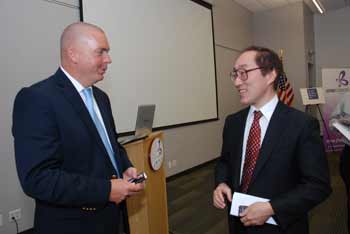

Event Report
By Alex Forbess
 After a 9.0-magnitude earthquake devastated the Tohoku region on March 11, 2011, massive waves destroyed towns up and down the coastline of Miyagi and Iwate prefectures causing catastrophic damage to the area. At the time, Dr. Robert D. Eldridge, Political Affairs and Public Diplomacy Officer, Marine Corps Installation Pacific, was with the 31st Marine Expeditionary Unit (MEU) in Okinawa, approximately over 1,500 miles from the earthquake’s epicenter. “Even being in Okinawa, we knew how bad it was going to be,” Eldridge said. The 31st MEU immediately prepared to assist the Japan Ground Self Defense Force (JGSDF) and once Operation Tomadachi was approved by the US government in Washington DC.
After a 9.0-magnitude earthquake devastated the Tohoku region on March 11, 2011, massive waves destroyed towns up and down the coastline of Miyagi and Iwate prefectures causing catastrophic damage to the area. At the time, Dr. Robert D. Eldridge, Political Affairs and Public Diplomacy Officer, Marine Corps Installation Pacific, was with the 31st Marine Expeditionary Unit (MEU) in Okinawa, approximately over 1,500 miles from the earthquake’s epicenter. “Even being in Okinawa, we knew how bad it was going to be,” Eldridge said. The 31st MEU immediately prepared to assist the Japan Ground Self Defense Force (JGSDF) and once Operation Tomadachi was approved by the US government in Washington DC.
Eldridge gave a presentation at the Japan Foundation, Los Angeles on Thursday, May 15th to discuss the joint task force developed by the 31st MEU and JGSDF. After receiving the orders, the US marines in Okinawa immediately rushed to the affected area to assist with the recovery. The JSDF and its officials were amazed of not only the quick responses, but how the 31st MEU used damaged facilities as command centers, such as the Sendai Airport. “At first, they written (that idea) off, but with the Marines, anything is good to use in a disaster,” Eldridge said. Throughout the operation, the 31st MEU developed a clear plan with the JGSDF that the US would be present to provide humanitarian aid and not break sovereignty with Japan. Eldridge reflected how both nations worked well and made the joint force more of a “co-operation,” as he puts it.
On March 12, the Marines started deploying helicopters with troops and aid to areas such as Takata and Kesennuma. Lieutenant General Kimizuka, Commanding General of the Northeastern Army, and Lieutenant Glueck, Commanding General III MEF, met at Sendai on Mach 15 to coordinate aid delivery to civilians. With such a major section of the country affected, the local governments had to play a larger role in making this operation a success. “The central government will be busy so local governments and citizens would have to stand up,” Eldridge said. Many volunteers offered help, from children donating food to local officials providing housing for victims. While other US navy and marine groups helped clean up, the 31st MEU was assigned to help Oshima, a remote island off the coast of Kesennuma was isolated due to the aftershocks that followed 3.11. With only 3,000 citizens inhabiting the island, 31 people died. It was a miracle that Oshima was not wiped out. Citizens there were used to frequent earthquakes, large or small. As precaution, they developed quick emergency plans to move to higher ground and avoid the damage.
With things moving smoothly within the first week of April, the marines started pulling back as the JGSDF was able to handle more of the relief. Despite the horrendous events, bilateral relations increased between the US and Japan. Military and government officials, along with some private supporters, met at Shizuoka to discuss what they learned. Besides fully understanding the capability of the marines to work in land, air, and sea—which was proven as effective in the relief—they also decided to use the Oshima incident as a lesson for all regions of Japan. It was the perfect example of the local government’s ability to make quick decisions work cohesively. Eldridge states Operation Tomodachi as a success with the US Marine Corp and JGSF working together. It took the JGSF to realize that people are willing to help and when faced with a common disaster, we will assist each other because “Japan is our second home,” as Eldridge eloquently puts it.